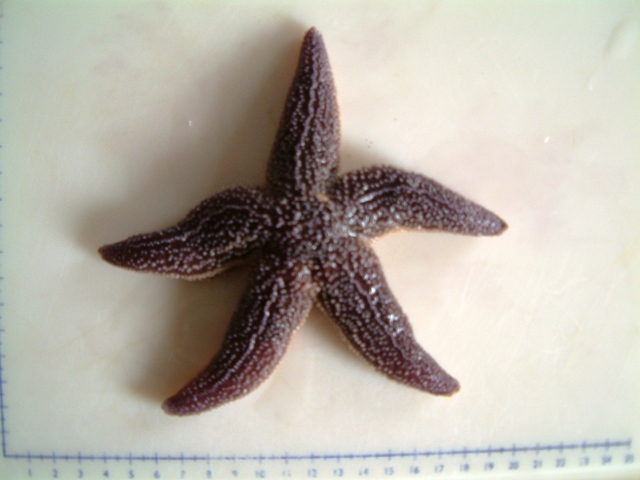Northern Sea Star

Scientific name: Asterias vulgaris
Phylum: Echinodermata
Class : Asteroidea
Description: A five armed sea star with prominent line of spines on the upper side of its arms. Each arm has four rows of tube feet. Colour can vary from red to brown, purple or green. It can grow up to 30cm in diameter.
Distribution: The most common sea star in Atlantic waters, the Northern sea star can tolerate low salinity, brackish water. They are common in rocky tide pools and near jetties and pilings but also occur on sandy or stony bottom. Though normally benthic, they can free float and drift on strong currents. They are often found on mussel beds where prey is abundant.
Locomotion: They use “tube feet” which are connected to ampullae to move. When ampullae contract, fluid is forced into the tube feet, extending them; small muscles direct the tube feet in one direction or another. Sea stars migrate to deeper water in winter. An active individual could travel a mile in about a week.
Food gathering: Northern sea stars are generally opportunistic scavengers, they use tube feet to hold shells of bivalves like mussels, clams, and oysters; they also feed on snails and limpets. The everted stomach slips into the shell of prey and digestive enzymes are released in order to digest the soft parts of the prey.
Gas exchange:Gas exchange occurs across the podia and special out-pocketing of body wall. The currents move in opposite directions, creating a countercurrent and maximizing exchanges gradients.
Reproduction: The sexes are separated, with eggs being fertilized externally. It has free-floating eggs and complexly metamorphosing young and pelagic larval stages.
Interesting facts: Sea stars are menace on oyster beds, scallop and mussel aquaculture. They are capable of regenerating lost or damaged arms. Sometimes the Northern Sea star steals the prey of its relative, the Polar Sea star.
Images
 |
 |
 |
 |
OSC Research
Mercier Lab - Research on reproduction, larval development, ecology and growth is carried out on a wide variety of marine invertebrates in this lab.